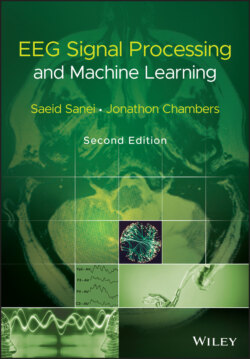Читать книгу EEG Signal Processing and Machine Learning - Saeid Sanei - Страница 31
2.7 Abnormal EEG Patterns
ОглавлениеVariations in the EEG patterns for certain states of the subject indicate abnormality. This may be due to distortion and disappearance of abnormal patterns, appearance and increase of abnormal patterns, or disappearance of all patterns. Sharbrough [37] divided the nonspecific abnormalities in the EEGs into three categories: (i) widespread intermittent slow‐wave abnormalities often in the delta wave range and associated with brain dysfunction, (ii) bilateral persistent EEG usually associated with impaired conscious cerebral reactions, and (iii) focal persistent EEG usually associated with focal cerebral disturbance.
The first category is a burst type signal, which is attenuated by alerting the individual and eye opening, and accentuated with eye closure, hyperventilation, or drowsiness. The peak amplitude in adults is usually localized in the frontal region and influenced by age. In children, however, it appears over the occipital or posterior head region. Early findings showed that this abnormal pattern frequently appears with an increased intracranial pressure with tumour or aqueductal stenosis. Also, it correlates with grey matter disease, both in cortical and subcortical locations. However, it can be seen in association with a wide variety of pathological processes varying from systemic toxic or metabolic disturbances to focal intracranial lesions.
Regarding the second category, i.e. bilateral persistent EEG, the phenomenon in different stages of impaired, conscious, purposeful responsiveness are etiologically nonspecific and the mechanisms responsible for their generation are only partially understood. However, the findings in connection with other information concerning aetiology and chronicity may be helpful in arriving more quickly at an accurate prognosis concerning the patient's chance of recovering his previous conscious life.
As for the third category, i.e. focal persistent EEG, these abnormalities may be in the form of distortion and disappearance of normal patterns, appearance and increase of abnormal patterns, or disappearance of all patterns, but such changes are seldom seen at the cerebral cortex. The focal distortion of normal rhythms may produce an asymmetry of amplitude, frequency, or reactivity of the rhythm. The unilateral loss of reactivity of a physiological rhythm, such as the loss of reactivity of the alpha rhythm to eye opening [38] or to mental alerting [39], may reliably identify the focal side of abnormality. A focal lesion may also distort or eliminate the normal activity of sleep‐inducing spindles and vertex waves.
Focal persistent nonrhythmic delta activity (PNRD) may be produced by focal abnormalities. This is one of the most reliable findings of a focal cerebral disturbance. The more persistent, the less reactive, and the more nonrhythmic and polymorphic is such focal slowing, the more reliable an indicator it becomes for the appearance of a focal cerebral disturbance [40–42]. There are other cases such as focal inflammation, trauma, vascular disease, brain tumour, or almost any other cause of focal cortical disturbance, including an asymmetrical onset of CNS degenerative diseases that may result in similar abnormalities in the brain signal patterns.
The scalp EEG amplitude from cerebral cortical generators underlying a skull defect is also likely to increase unless acute or chronic injury has resulted in significant depression of underlying generator activity. The distortions in cerebral activities are because focal abnormalities may alter the interconnections, number, frequency, synchronicity, voltage output, and access orientation of individual neuron generators, as well as the location and amplitude of the source signal itself.
With regards to the three categories of abnormal EEGs, their identification and classification requires a dynamic tool for various neurological conditions and any other available information. A precise characterization of the abnormal patterns leads to a clearer insight into some specific pathophysiologic reactions, such as epilepsy, or specific disease processes, such as subacute sclerosing panencephalitis (SSPE) or Creutzfeldt–Jakob disease (CJD) [37].
Over and above the reasons mentioned above there are many other causes for abnormal EEG patterns. The most common abnormalities are briefly described in the following sections.
